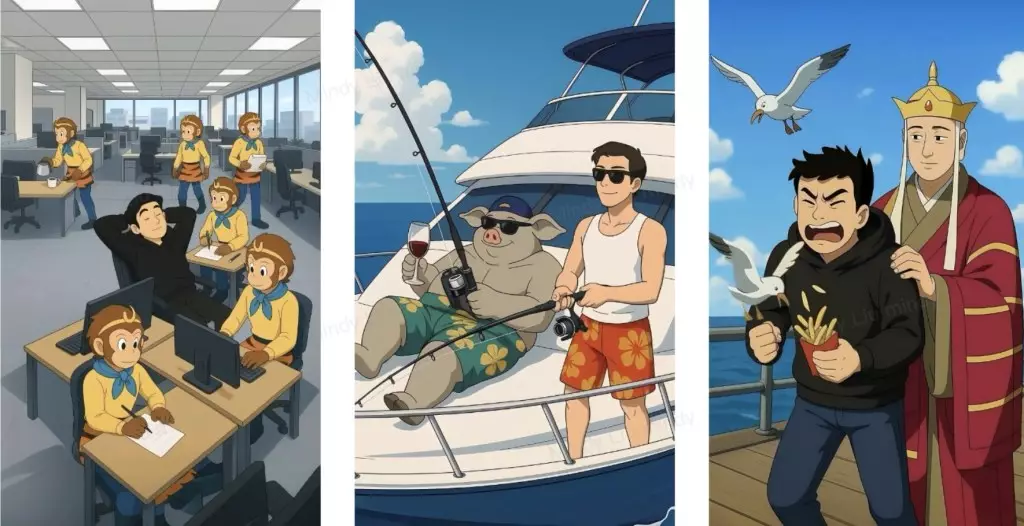The world of animation is experiencing a seismic shift, driven by the inexorable march of technology. Chinese AI video generator Vidu is at the forefront of this transformation with their recent intellectual property (IP) deal, allowing them to utilize elements from the beloved 1999 animated series, *Journey to the West: Legends of the Monkey King*. This innovative collaboration empowers users to upload a single photo and reimagine themselves within the iconic framework of the series. The implications of such technology extend far beyond mere entertainment; they signal a revolutionary approach to content creation that emphasizes user engagement and personal connection.
The significance of this deal lies not just in its novelty but in how it illustrates a crucial change in the interaction between artificial intelligence and established creative works. By permitting users to input their likeness into settings inspired by a nostalgic cultural touchstone, Vidu has opened the floodgates to a new form of artistic expression. The ability to take a slice of cultural heritage and weave personal narratives into it speaks volumes about our evolving relationship with media. As we delve deeper into the artist-user dynamic, it becomes clear that Vidu is not merely capitalizing on public sentiment; they are crafting a platform for co-creation, allowing fans to become integral parts of the storytelling process.
The Context of AI in Animation
Vidu’s announcement came amidst heightened scrutiny and backlash faced by major AI platforms like OpenAI, specifically regarding their Sora video generation model, which similarly allows for personal creativity using existing animation styles, like that of Studio Ghibli. The discontent expressed by Ghibli’s founder Hayao Miyazaki illustrates the delicate balance between innovation and respect for artistic legacy. This is a key consideration that Vidu appears to be addressing head-on. Their approach of securing long-term IP rights demonstrates a commitment to preserving the integrity and artistry of original works while simultaneously exploring new avenues for creative engagement.
In this landscape of generative AI, Vidu is not just reacting to existing concerns but proactively redefining the parameters of what it means to engage with animation. They invite users to become co-creators, transforming a static relationship with animation into an active, participatory model. This distinct pivot indicates that generative AI can be a medium for ownership rather than a mere tool for content generation.
Transforming Personal Experiences
The mechanics of Vidu’s platform are as intriguing as their philosophy. Users can expect to transform their photos into the vibrant art style of *Journey to the West*, which is not only visually striking but also allows for personalized storytelling. By selecting from various plotlines, users can weave their stories into the rich tapestry of Monkey King adventures. The example of Sun Wukong humorously engaging with a user’s digital avatar reveals a layered approach to interaction; it’s not just about transportation into the world of the series, but a chance for users to inhabit that world in a uniquely personal way.
This personalized approach not only appeals to nostalgia but also builds a bridge for younger audiences who may be less familiar with the series. By midwifing this interaction through technology, Vidu ensures that timeless tales remain relevant and engaging to new generations. This cultural continuity is vital, especially in an era where rapid technological change can often lead to a disconnect from our heritage.
A Catalyst for Future Creativity
Luo Yihang, CEO of Beijing-based ShengShu Technology, articulates a vision where generative AI transcends its role as a behind-the-scenes player, morphing instead into a powerful force for ownership and world-building. This philosophy encapsulates the broader implications of Vidu’s initiative: it’s not merely a new tool; it represents a paradigm shift in how we interact with art and story. The traditional boundaries of creation are dissolving, as audiences now have the potential to leave their indelible marks on cherished narratives.
In essence, Vidu serves as a beacon for future endeavors in AI-driven creativity. As they champion the cause of co-creation and cultural expression, they illustrate that generative AI is not simply about automation but about fostering artistic legacies adapted for a contemporary audience. Such ventures point toward a future where storytelling is collectively constructed—and that is a future we should all be excited about. The doors to creativity are being swung wide open, allowing anyone with a story to tell to step inside and begin their own animated adventure.

